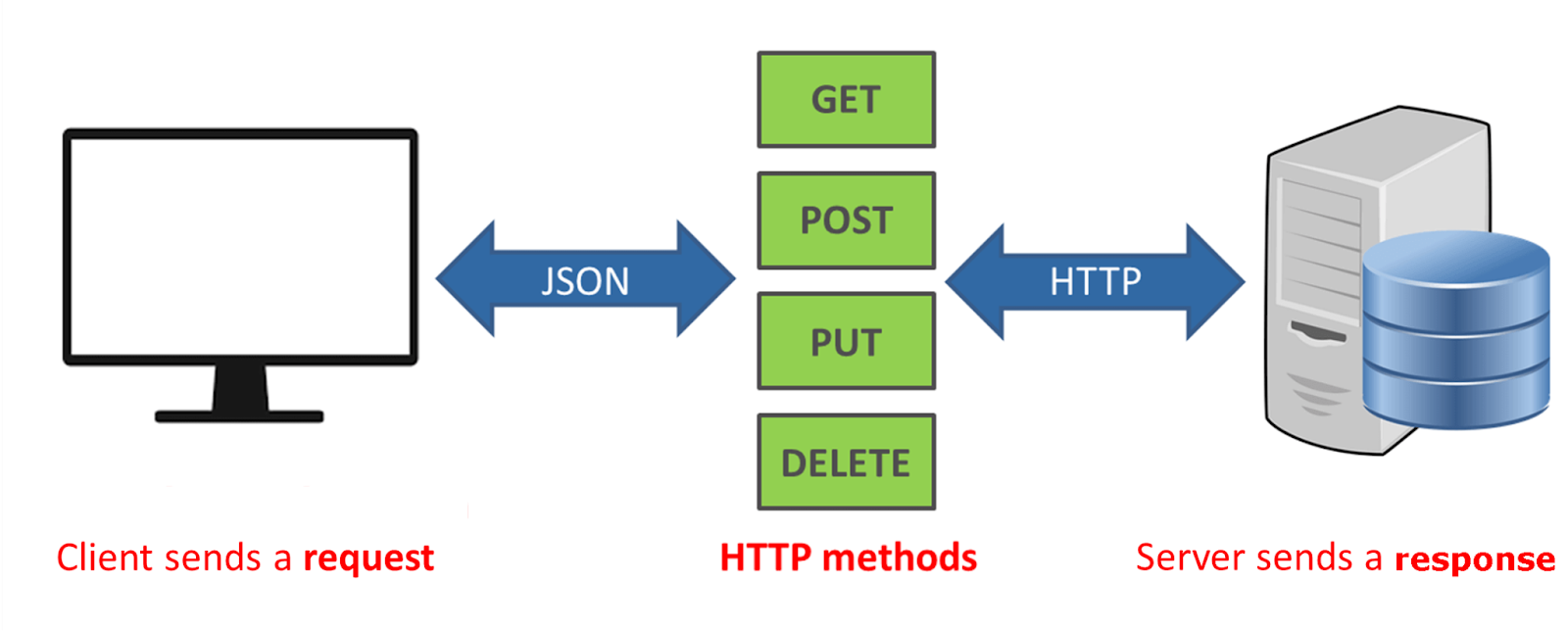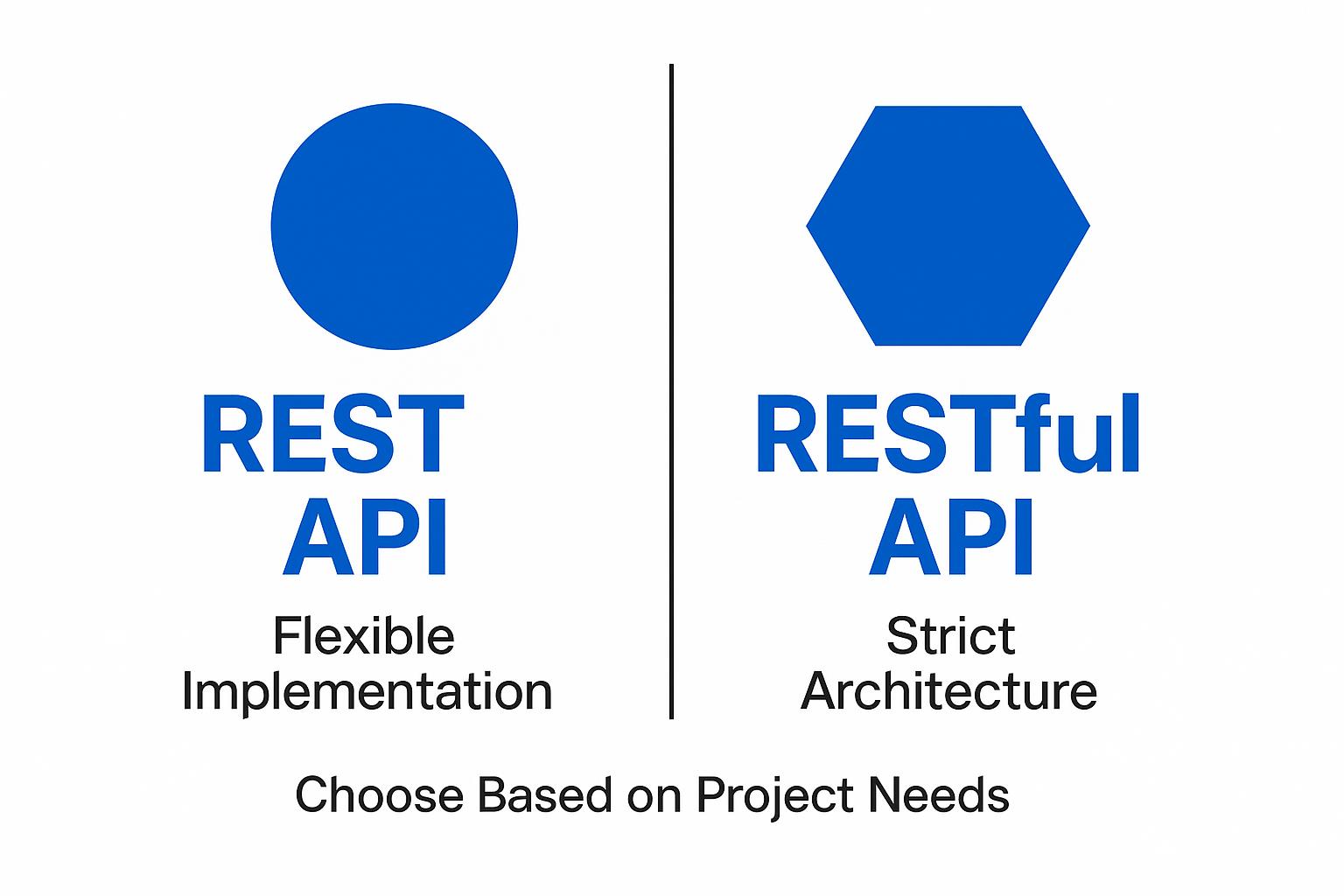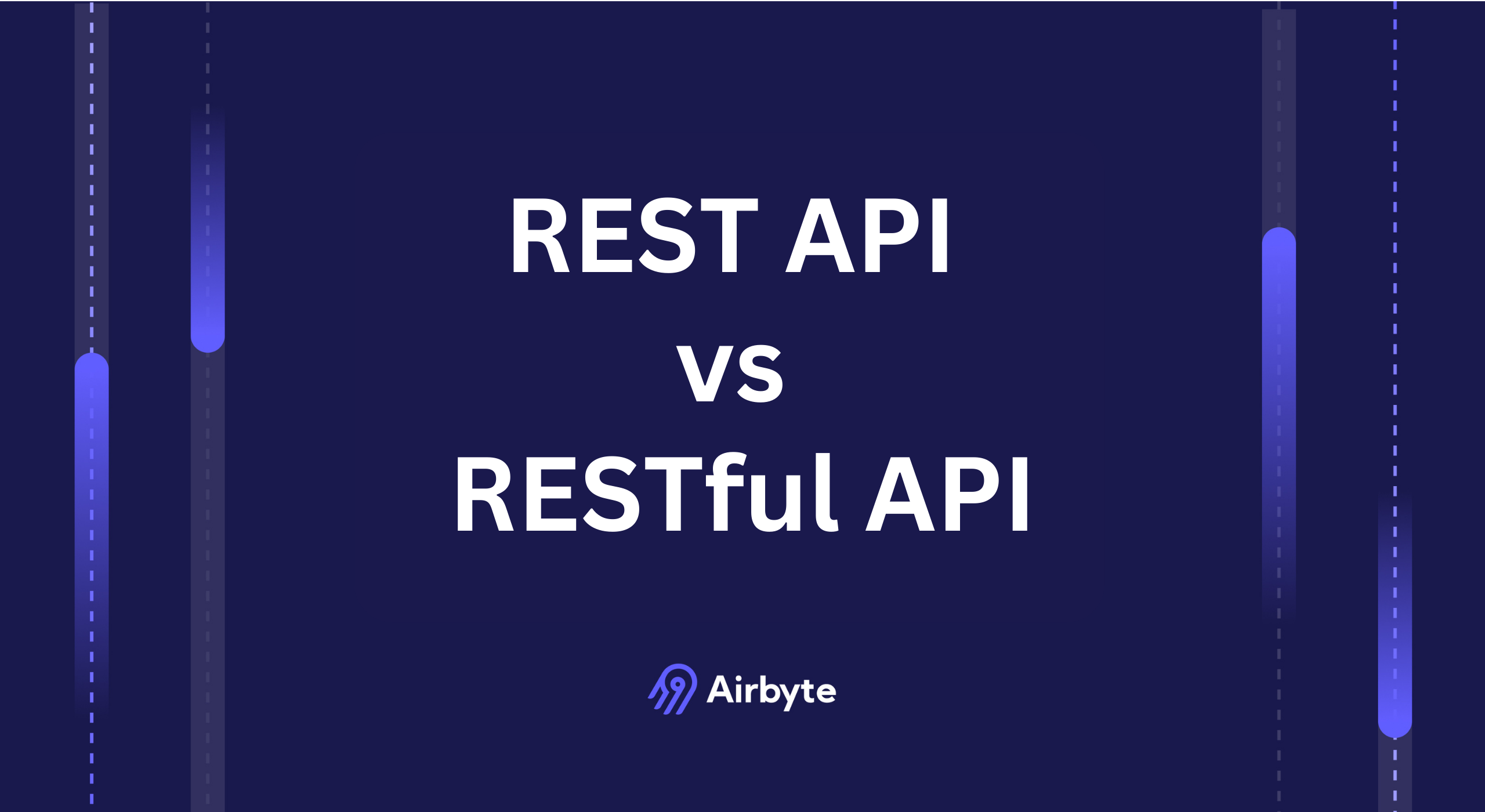REST API vs RESTful API - Key Differences
Summarize this article with:
✨ AI Generated Summary
REST APIs enable communication between software applications using HTTP, offering simplicity, scalability, and platform independence, but may lack strict adherence to REST principles and built-in security. RESTful APIs strictly follow REST architectural constraints, providing enhanced security, consistent interfaces, better scalability, and standardized data handling.
- REST APIs are suitable for rapid prototyping and simpler projects, while RESTful APIs are ideal for complex, large-scale, and enterprise applications.
- RESTful APIs support token-based authentication, explicit caching, and uniform resource representations, improving performance and security.
- Integration with tools like Airbyte enhances REST API data extraction and pipeline management with advanced features and secure authentication.
- AI-powered tools automate API development and testing, improving efficiency and security validation.
With data being generated from various sources and touchpoints, organizations need secure and efficient means to capture important information. Application Programming Interfaces (APIs) serve as mechanisms that allow two software applications to communicate and transfer data seamlessly. The fundamental challenge lies in choosing the right API architecture that balances flexibility, security, and scalability for your specific use case.
This comprehensive guide examines the REST API vs RESTful API comparison, illustrating all the details and differences between both approaches while providing practical guidance for implementation decisions.
What Defines a REST API and Its Core Characteristics?
A Representational State Transfer Application Programming Interface (REST API) is an architectural style for building networked applications that interact over HTTP. It provides a standardized way for you to access, use, and modify resources on a server while creating efficient web applications that can scale across distributed systems.
REST APIs employ a layered architecture where the application, known as the client, operates separately from the server. This separation allows software to request data from a server through intermediaries like load balancers and proxies, enhancing scalability and overall performance. The architectural separation ensures that client and server can evolve independently without breaking the communication contract.
In a REST API, data entities are organized as unique URI (Uniform Resource Identifier) endpoints that represent specific resources. When you make a request to a specific URI, the REST API provides you with the requested data, which can include web pages, videos, images, and documents. Each REST API request operates independently, where the server does not retain client state between requests, enabling horizontal scaling and fault tolerance.
REST APIs communicate through HTTP requests to help you perform database functions like creating, reading, updating, and deleting records. The four standard HTTP methods include GET for retrieving records, POST for creating new records, PUT for updating existing records, and DELETE for removing records. This standardized approach ensures consistency across different implementations and simplifies client development.
What Are the Primary Advantages of REST APIs?
- Ease of Use: REST APIs are accessible and manageable for team members with limited experience in web development and programming. Their simplicity of design makes them approachable for those familiar with HTML, Python, or JavaScript, reducing the learning curve for development teams.
- Lightweight Operations: One of the key advantages of REST APIs is their platform-agnostic nature and ability to handle various data formats. This flexibility makes them suitable for conducting fast and lightweight operations, particularly valuable in mobile applications and IoT devices where bandwidth and processing power are limited.
- Independent Layers: REST APIs promote clear separation between client and server components, allowing user interface and data storage layers to operate autonomously. This separation helps development teams work on different parts of a project simultaneously, making it easier to test and experiment without affecting bandwidth efficiency or system stability.
What Challenges Do REST APIs Present?
- Limited Security Features: REST API architecture does not inherently include built-in security features, making them less suitable for transmitting sensitive information without additional security implementations.
- Design Limitations: REST APIs depend heavily on web connectivity, and this dependency prevents you from modifying or testing the API offline. Any changes must be implemented online, which can be challenging in low-connectivity environments or during development phases where network access is restricted.
How Does REST API Integration Work with Robust Data Movement Tools like Airbyte?
REST APIs provide an efficient method for extracting data from different servers and source systems. However, when you integrate REST APIs with modern data platforms like Airbyte, you can extract and consolidate data from multiple sources more effectively while maintaining enterprise-grade security and governance.

Airbyte is a comprehensive data integration platform that offers an extensive library of 600+ connectors, enabling organizations to build data pipelines efficiently. The platform supports multiple development approaches, including its no-code Connector Builder with AI-assistant capabilities, low-code CDK, and PyAirbyte for Python-based integrations.
Airbyte provides a robust API framework that enables programmatic interaction with the platform's features across all deployment options: Airbyte Cloud, Open Source, and Self-Managed Enterprise. Through the Airbyte API, you can extend workflow capabilities by integrating data pipelines with orchestration tools like Airflow and building platforms that are Powered by Airbyte. This integration approach provides complete control over data pipeline management while ensuring seamless data flow across your entire infrastructure.

For Airbyte Cloud users, you must create an application and obtain an access token through the Airbyte UI to make API requests. The platform provides comprehensive documentation for this process, ensuring secure authentication and authorization for all API interactions.
When leveraging Airbyte's Python SDK to make API requests directly in code, you can build source connectors for HTTP REST APIs with advanced functionality. These API-based connectors include helper functions for handling pagination, authentication, caching, and error handling. You can customize features according to your specific requirements and combine them with other stream features such as incremental synchronization and full refresh capabilities.
What Distinguishes RESTful APIs from Standard REST APIs?

A RESTful API is an interface that enables two systems to securely exchange data over the internet using HTTP protocols while strictly adhering to REST architectural principles. These APIs are built on the complete set of REST constraints and provide a more structured approach to API design compared to standard REST APIs.
RESTful APIs access and manipulate data through HTTP GET, POST, PUT, and DELETE requests, but they incorporate additional architectural components that enhance their scalability and versatility. The strict adherence to REST principles ensures consistent behavior across different implementations and environments.
The metadata in HTTP headers plays a crucial role in RESTful APIs, defining connection types, content formats, and caching directives for all requests and responses. The payload contains the actual data formatted according to the specified content type in the header. This structured approach ensures that RESTful APIs maintain compatibility with different programming languages and platforms, making them essential components of modern web applications and microservices architectures.
What Are the Key Advantages of RESTful APIs?
- Enhanced Security: RESTful APIs support the implementation of token-based authentication systems where unique tokens serve as secure credentials for data access.
- Highly Scalable: Their strict adherence to REST principles allows you to introduce new features or extend functionality without overhauling existing infrastructure.
- Cost-Effective: RESTful APIs leverage existing HTTP infrastructure, eliminating the need to purchase additional hardware or specialized software.
What Challenges Do RESTful APIs Present?
- Varied Data Fetching: Requests can return too much or too little data, potentially increasing bandwidth usage.
- Manipulation of Requests: Modifying HTTP requests may introduce design inconsistencies, complicating integration and maintenance.
How Do AI-Powered Tools Enhance REST API Development and Testing?
Modern API development increasingly leverages artificial intelligence to automate complex tasks and improve overall efficiency. Large Language Models (LLMs) can understand and generate API specifications automatically, extract constraints from natural language, create intelligent test parameters, and generate context-aware validation rules. AI-powered testing tools also generate comprehensive test suites, realistic test data, and identify security vulnerabilities before deployment.
What Are the Essential Security Considerations for REST APIs in Enterprise Environments?
Enterprise REST API security requires heightened attention given the current threat landscape. Essential security measures include a zero-trust approach, token-based authentication (OAuth 2.0, JWT), API gateways for rate limiting and threat detection, end-to-end encryption (TLS), robust logging and monitoring, comprehensive input validation, and role-based access control (RBAC).
What Are the Fundamental Differences Between REST API and RESTful API?
The main difference between REST API and RESTful API is that REST API refers to any API following REST principles, while RESTful API strictly adheres to REST architectural constraints, ensuring statelessness, uniform interfaces, and client-server separation.

How Do Architecture and Design Approaches Differ?
- REST API: Built on REST principles but may not follow all constraints; pragmatic compromises are common.
- RESTful API: Strictly follows all REST constraints, resulting in more modular architectures.
What Distinguishes Data Handling and Format Support?
- REST API: Often limited to JSON or XML and can vary in representation consistency.
- RESTful API: Supports additional formats (HTML, YAML, plain text) while maintaining consistent structures.
How Does Interface Consistency Vary Between Approaches?
- REST API: Interfaces may vary between endpoints.
- RESTful API: Ensures uniform resource representations across all endpoints.
What Are the Caching Capabilities and Performance Implications?
- REST API: Caching may be ad-hoc or inconsistent.
- RESTful API: Implements explicit caching strategies with headers and conditional requests.
How Do Security Implementations Compare?
- REST API: Can be secure but may introduce gaps due to inconsistencies.
- RESTful API: Generally offers stronger foundations for security due to strict adherence to statelessness and uniform interfaces.
What Is the Complete Comparison Between REST API and RESTful API?
How Do You Choose Between REST API and RESTful API for Your Project?
The shift toward API-first development methodologies has accelerated dramatically, making architectural decisions increasingly critical for long-term success.
What Role Does Project Complexity Play in Your Decision?
- REST API: Ideal for simple projects with straightforward data access requirements.
- RESTful API: Better suited for complex, large-scale projects requiring data standardization and flexibility.
How Should Data Scalability Requirements Influence Your Choice?
- Smaller applications: REST APIs often suffice.
- Large, high-traffic platforms: RESTful APIs provide the scalability and consistency required.
What Data Integration Platform Considerations Matter?
- Modern, well-documented ecosystems: RESTful APIs simplify management.
- Legacy or non-standard systems: REST APIs may offer the necessary flexibility.
How Does Development Speed Impact Your Decision?
- Rapid prototyping: REST APIs reduce initial overhead.
- Long-term robustness: RESTful APIs justify the extra initial investment.
Final Recommendation for REST API vs RESTful API Selection
REST APIs offer simplicity and speed, making them suitable for rapid prototyping, legacy system integration, and projects with limited architectural complexity. RESTful APIs, on the other hand, provide architectural uniformity, enhanced security, and superior scalability, making them ideal for enterprise applications and long-term system development.
Evaluate your project scope, team expertise, existing infrastructure, and future scalability needs. For complex integration, high-volume data processing, or significant system growth, prioritize RESTful APIs. For quick delivery and straightforward integrations, REST APIs may be sufficient.
Frequently Asked Questions
What Is the Main Technical Difference Between REST and RESTful APIs?
REST APIs follow REST principles but may not implement all architectural constraints, allowing for pragmatic compromises during development. RESTful APIs strictly adhere to all REST constraints including statelessness, uniform interfaces, and client-server separation, ensuring consistent behavior across all endpoints and implementations.
Can a REST API Be Converted to a RESTful API?
Yes, a REST API can be converted to a RESTful API by implementing strict adherence to all REST architectural constraints. This conversion typically involves standardizing resource representations, ensuring stateless operations, implementing uniform interfaces, and adding proper HTTP header management for caching and content negotiation.
Which API Type Is Better for Mobile Applications?
RESTful APIs are generally better for mobile applications because their strict architectural constraints ensure consistent performance, efficient caching, and reliable behavior across different network conditions. The standardized approach reduces bandwidth usage and provides predictable responses that mobile applications require for optimal user experience.
How Do REST and RESTful APIs Handle Authentication Differently?
REST APIs can implement authentication in various ways, potentially creating inconsistencies across different endpoints. RESTful APIs typically implement standardized authentication patterns using HTTP headers and tokens, ensuring consistent security behavior across all resources and simplifying client authentication implementation.
What Are the Performance Implications of Choosing RESTful Over REST APIs?
RESTful APIs often provide better performance due to systematic caching strategies, consistent resource representations, and optimized HTTP header usage. While REST APIs offer implementation flexibility that can lead to performance optimizations in specific cases, RESTful APIs provide predictable performance patterns that scale better in distributed systems.

.webp)
